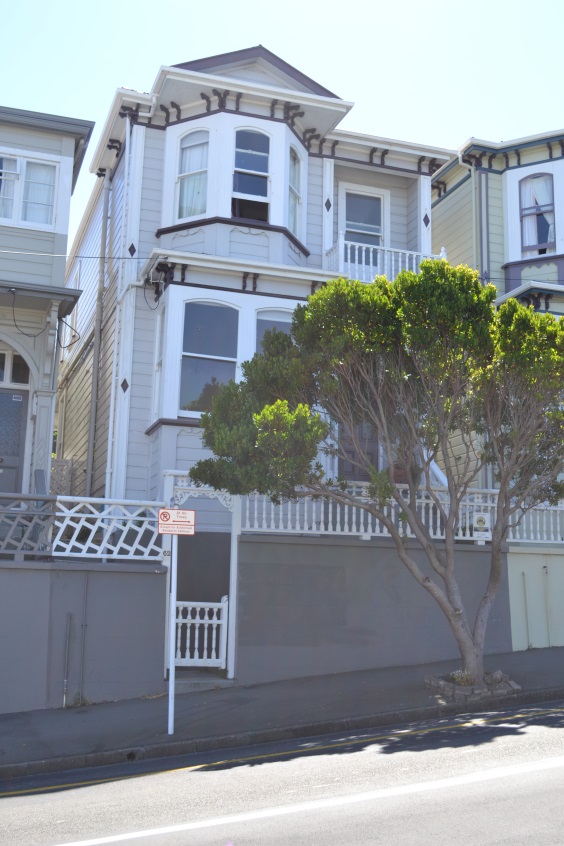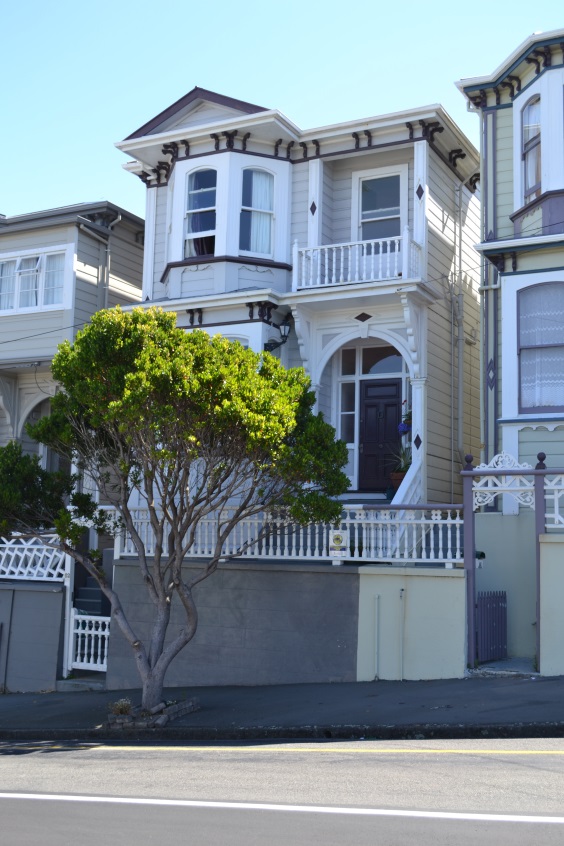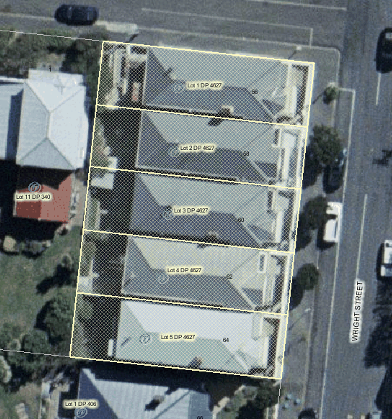House
-
Constructed
1905
-
-
Architect(s)
-
Builder(s)
Harry Crump
-
56, 58, 60, 62 and 64 Wright Street are a group of five two-storey villas designed in a distinctive San Francisco / Italianate-style. They are notable for their well-proportioned Classical facades and for their elaborate decorative schemes and ornamentation.
The row of five villas is a local landmark. Their location as a stepped row, elevated above the southern slope of Wright Street, provides a distinct visual interest to the street and contributes to the character and sense of place of the surrounding area. They have group value for their near identical design and histories.
Although it seems likely that none of the houses (or their occupants) have had a notable or unusual history, the group of houses can be seen as representative of the development of the Newtown/Mount Cook area.
-
Downloadable(s)
-
close
History
-
These five houses on the west side of Wright Street in Mount Cook were built in the Italianate style by Harry Crump, in 1905. Harry Crump (1856 – 1949) was a prolific speculative builder who is known to have been active in Wellington in the years between 1892 and 1908. He was born in Yorkshire, and spent part of his childhood in the USA before returning to England to serve his apprenticeship - presumably as a builder. He sailed to New Zealand on the ‘Maraval’ in 1880 and built over 156 houses in Kelburn, Thorndon, Te Aro, Mount Cook, and Newtown. He also owned large areas of land in Newtown and Thorndon, and is associated with the development of Lauriston Street (now Patterson Street) in Mount Victoria, Myrtle Crescent in Mt Cook, and Kensington Street in Te Aro. He is likely to have worked as an architect-builder as most of his building consent applications do not list separate architects.
The 1891 Te Aro Thomas Ward survey map shows that Wright Street and Salisbury Terrace had been substantially developed by the end of the nineteenth century. This is unsurprising as the Cook Ward, which included part of Mount Cook, Mount Victoria and Newtown, had adsorbed over half Wellington’s population growth in the years between 1878 and 1901. Suburban growth was further stimulated by the development and expansion of the electric tram network from 1904 onwards, and Wright Street would have been a prime site for development, due to its proximity to the city and to tramlines that were located in nearby Adelaide Road, and later in Wallace Street.
Crump purchased the land at the corner of Salisbury Terrace and Wright Street in 1903 that had once been occupied by a large villa, perhaps built by solicitor, Frederick Wilson. Wilson subdivided the land into two titles and sold both to Crump in 1903, and Crump lodged the building consent application for the five houses in August 1905 with an estimated construction cost of £3000.
Crump owned all five houses until 1913 when they were sold to Margaret Price, wife of Wellington builder, Charles Price. The land was re-surveyed and subdivided into individual titles in 1920. Lots 1, 2, 4 and 5 were transferred to the Crown for housing purposes, and Lot 3 was transferred to Mary Davis in 1921. The houses returned to private ownership in the 1920s – 40s and have generally been occupied by middle-class tenants over the past 100+ years. All appear to have been converted into two flats at some time, and all but one appear to have since been returned to single dwellings.
Although it seems likely that none of the houses (or their occupants) have had a notable or unusual history, the group of houses can be seen as representative of the development of the Newtown/Mount Cook area. NZHPT note that ‘their representative, or typical nature in terms of their origins and history, are arguably of more general utility in this way than something less common.’
The NZHPT created the Wright Street Historic Area in 2005 and this replaced the previous Category II Historic Place status for each individual house.
-
Modifications
close
-
1905
-
(00053:120:6675); 56, 58, 60, 62, 64 Wright Street, five dwellings; (00432:573:48476); 56, 58, 60, 62, 64 Wright Street
-
1968
-
(00058:592:C27951); 62 Wright Street, re-pile
-
1996
-
(00061:211:16673); 62 Wright Street, plumbing alterations
-
2002
-
(00078:1031:92914); 62 Wright Street, removal of wall between kitchen and dining area, covering of laundry, installation of French doors and new kitchen
-
2003
-
(00078:1040:97330); 62 Wright Street, alterations to first floor bathroom; renewal of shower and wash-basin plus installation of wc
-
-
Occupation History
close
Not assessed
-
These five houses on the west side of Wright Street in Mount Cook were built in the Italianate style by Harry Crump, in 1905. Harry Crump (1856 – 1949) was a prolific speculative builder who is known to have been active in Wellington in the years between 1892 and 1908. He was born in Yorkshire, and spent part of his childhood in the USA before returning to England to serve his apprenticeship - presumably as a builder. He sailed to New Zealand on the ‘Maraval’ in 1880 and built over 156 houses in Kelburn, Thorndon, Te Aro, Mount Cook, and Newtown. He also owned large areas of land in Newtown and Thorndon, and is associated with the development of Lauriston Street (now Patterson Street) in Mount Victoria, Myrtle Crescent in Mt Cook, and Kensington Street in Te Aro. He is likely to have worked as an architect-builder as most of his building consent applications do not list separate architects.
-
close
Architectural Information
-
Building Classification(s)
close
Not assessed
-
Architecture
close
The Wright Street houses are a unique group of near-identical two-storey villas designed in a San Francisco-inspired style. They are stylistically similar to the housing developments of San Francisco, particularly those designed by the American West Coast Newsom brothers, according to architect and historian, Martin Hill. Others, including conservation architect Ian Bowman, describe the houses as an exclusively timber form of the Italianate-style that evolved in both New Zealand and San Francisco, and was popular with speculative builders at the end of the nineteenth century.
Each house was designed with a rectangular bay window at the ground floor, surmounted by a ‘lighter’ semi-octagonal window above, and the bay roof forms alternate between hipped roof and flying gable. The bays stand in contrast to the recessed porches which are generally decorated with an ‘Eastern horseshoe arch’ at first floor level. Although the houses were designed as near-identical there is some variation in the roof form (as noted above); in the detail of the first floor balcony balusters, gates, and matching street-wall topping rail; and in decorative features such as the balcony brackets and sill apron-board details.
No. 62
Has no horseshoe arch at the first floor balcony and this detracts from the composition of the group of houses. -
Materials
close
Timber structural framing, floor joists and rafters
Rusticated timber weatherboards
Timber decorative features and ornamentation
Timber sash windows and door joinery
-
Setting
close
The Wright Street houses are a photogenic row of five near-identical, two-storey villas that step down the southern slopes of Wright Street. Each house is set back approximately two metres from the Wright Street boundary and the houses are spaced to allow for a narrow side yard to the south that gives access to a small rear yard. Each house is set approximately two metres above street level and this position allows the row to be viewed as a whole and enhances its visual impact.
The houses’ distinctive San Francisco / Italianate-style, their arrangement as a stepped group, the repetition of key features including the bay windows and horseshoe arches establish a visual rhythm on the Wright Street streetscape.
The buildings are designed to be superficially similar, but the streetscape is further enlivened by variations in decorative schemes, roof form and ornamentation.
The wider setting for the five near-identical houses is the residential streetscape of Wright Street, a wide undulating street, with an interesting mix of houses, many of them dating from the early decades of the 20th century. Houses 56, 58, 60, 62 & 64 stand at the highest point of the street - near the south end - with No. 64 being the southernmost one.
-
Building Classification(s)
close
-
close
Cultural Value
56, 58, 60, 62 and 64 Wright Street are a group of five two-storey villas designed in a distinctive San Francisco / Italianate-style. They are notable for their well-proportioned Classical facades and for their elaborate decorative schemes and ornamentation.
The row of five villas is a local landmark. Their location as a stepped row, elevated above the southern slope of Wright Street, provides a distinct visual interest to the street and contributes to the character and sense of place of the surrounding area. They have group value for their near identical design and histories.
Although it seems likely that none of the houses (or their occupants) have had a notable or unusual history, the group of houses can be seen as representative of the development of the Newtown/Mount Cook area.
-
Aesthetic Value
close
-
Architectural
Does the item have architectural or artistic value for characteristics that may include its design, style, era, form, scale, materials, colour, texture, patina of age, quality of space, craftsmanship, smells, and sounds?
56, 58, 60, 62 and 64 Wright Street are a group of five two-storey villas designed in a distinctive San Francisco / Italianate-style. They are notable for their well-proportioned Classical facades and for their elaborate decorative schemes and ornamentation
-
Townscape
Does the item have townscape value for the part it plays in defining a space or street; providing visual interest; its role as a landmark; or the contribution it makes to the character and sense of place of Wellington?
The row of five villas is a local landmark. Their location as a stepped row, elevated above the southern slope of Wright Street, provides a distinct visual interest to the street and contributes to the character and sense of place of the surrounding area. They have group value for their near identical design and histories.
-
Group
Is the item part of a group of buildings, structures, or sites that taken together have coherence because of their age, history, style, scale, materials, or use?
This row of five Edwardian villas have group value for their near identical design and history.
-
-
Historic Value
close
-
Assocation
Is the item associated with an important historic event, theme, pattern, phase, or activity?
Although it seems likely that none of the houses (or their occupants) have had a notable or unusual history, the group of houses can be seen as representative of the development of the Newtown/Mount Cook area.
-
- Scientific Value close
-
Social Value
close
-
Identity Sense of place Continuity
Is the item a focus of community, regional, or national identity? Does the item contribute to sense of place or continuity?
The group of buildings has had few intrusive modern alterations and additions (with the notable exception of the first floor balconies at No. 56 & No. 64) over the past 100+ years and contribute to the sense of place and continuity of Wright Street.
-
-
Level of Cultural Heritage Significance
close
-
Rare
Is the item rare, unique, unusual, seminal, influential, or outstanding?
The buildings are a relatively rare example of San Francisco / Italianate residential architecture in Wellington and are notable for the condition and survival of much of the original ornate timber decoration. The survival of the Wright Street houses as a group enhances this rarity value.
-
Representative
Is the item a good example of the class it represents?
The buildings are good representative examples of the type of Edwardian villas that were built by speculative builder/developers on sites across Wellington city and its newly emergent suburbs.
-
Authentic
Does the item have authenticity or integrity because it retains significant fabric from the time of its construction or from later periods when important additions or modifications were carried out?
The building exteriors have retained much of their original built fabric.
-
-
Local / Regional / National / International Importance
close
Not assessed
-
Aesthetic Value
close
-
close
Site Detail
-
District Plan Number
6/363.4
-
Legal Description
LOT 4 DP 4627
-
Heritage New Zealand Listed
Wright Street Houses Historic Area
-
Archaeological Site
Central City NZAA R27/270
-
Current Uses
unknown
-
Former Uses
unknown
-
Has building been funded
No
-
Funding Amount
Not applicable
-
Earthquake Prone Status
Outside Earthquake Prone Policy
-
-
close
Additional Information
-
Sources
close
- Hill, Martin. Restoring with style: Preserving the character of New Zealand’s houses, (Wellington: V.R. Ward, Government Printer, 1985), 36
- Irvine-Smith, F.L. The Streets Of My City, (Wellington, 1948)
- Pollock, Kerryn. Ian Bowman and Rebecca O’Brien, ‘Wright Street Houses Historic Area, Wright Street, Wellington’, Historic Area Registration Report for the NZHPT (2004)
- Schrader, Ben. 'Housing - Construction and materials', Te Ara - the Encyclopedia of New Zealand, updated 8-Jul-13
- The Cyclopedia of New Zealand [Wellington Provincial District] 1897.
- Technical Documentation close
-
Footnotes
close
Not available
-
Sources
close
Last updated: 11/28/2017 3:45:55 AM



